TARRYTOWN, NY
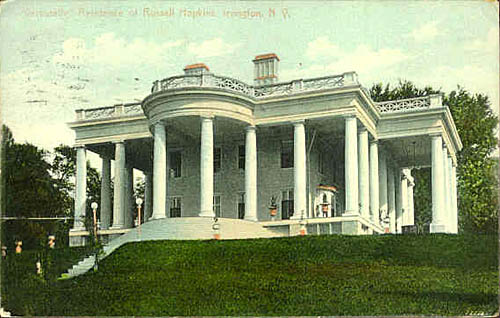
Postcard: " 'Veruselle' Residence of Russell Hopkins, Irvington, N.Y."

Postcard: " 'Veruselle' Residence of Russell Hopkins, Irvington, N.Y."
This house should be familiar to fans of the 1960s vampire
soap opera Dark Shadows, for it appeared in the television series as "The
Old House." The mansion, which had been vacant for about seven or eight years
by the late 1960s TV shoots, was used for exterior photography (although several images of
Jonathan Frid, in his role as Barnabas Collins, inside the mansion are known to
exist as well, but were not used on the show). This mansion likely came to the
attention of the casting crew owing to the fact that a more famous house,
Lyndhurst, stood next door (Lyndhurst served as Collinwood for both movie
versions of Dark Shadows).
The South End of Tarrytown, by virtue of its location 25
miles north of Manhattan, contained one of the greatest concentrations of estates
along the Hudson River. Washington Irving, who penned "The Legend of Sleepy
Hollow" and other famous tales, settled here in 1835. Irving remodeled a
colonial stone
tenant farmhouse into his Romanticized version of an early Dutch
mansion. His neighborhood became quite crowded after 1850, when the Hudson River
Rail Road enabled merchant millionaires to commute from home to New York City in
under an hour; mansions sprouted seemingly overnight on the shore overlooking
the Tappan Zee. A great number of homes were built in the 1850s and 1860s, but
by he 1880s many homes fell into disuse owing to high maintenance costs or because
their owners chose newly fashionable locales such as Newport, RI, for the
summer retreats. The area went through a bit of a revival in the early 1900s, as
more modern mansions replaced the older stone or brick houses.
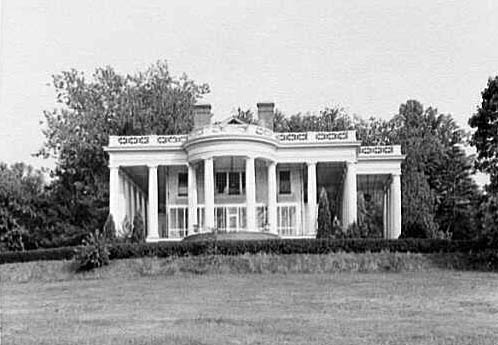
"Duchess de Talleyrand, Lyndhurst, residence in Irvington, New York. Cottage, river facade."
1943 Oct. 9.
Library of Congress, Prints and Photographs Division, Gottscho-Schleisner Collection,
Reproduction Number LC-G613-T-44127 DLC.
One of the first merchants to build here around 1850 was
Moses Hicks Grinnell, a one-time United States representative, real estate
developer, merchant, and financier. His high society connections extended beyond business; in
1836 Grinnell married Julia Irving, niece of the famous author Washington
Irving. It was immediately north of Irving's "Sunnyisde" that Grinnell
settled in the early 1850s. For himself, he built a mansion known as "Wolfert's
Dell;" about the same time or shortly thereafter, he built a second
mansion, similar in appearance to his own, on the northern portion of his
38-acre estate. In the 1850s, Grinnell's niece, Mary Russell Grinnell, resided
in the northerly mansion with her husband Henry Holdredge.
The historical path of the two houses diverged and converged
in the later part of the 1800s. at times, they were part of one estate, at
others separated. On occasion, the northerly house was part of the Lyndhurst
estate. In 1907, both houses came into ownership of Russell Hopkins, son of a prominent Atlanta banker, and his wife
Vera Siegrist, granddaughter of Dr. Joseph J. Lawrence, along with Jordan Wheat Lambert, invented
Listerine in 1879. The now famous mouthwash, originally intended as a
disinfectant for surgical procedures, was named after English physician Sir
Joseph Lister who, according to this website,
performed the first ever antiseptic surgery in 1865.
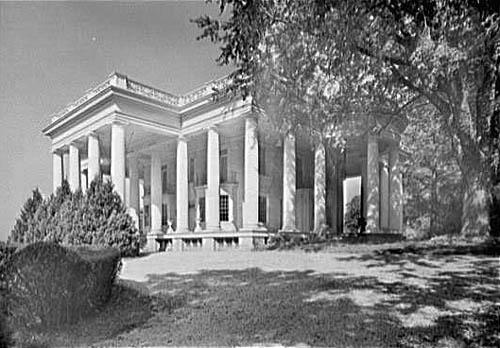
"Duchess de Talleyrand, Lyndhurst, residence in Irvington, New York. Cottage entrance, view II."
1943 Oct. 9.
Library of Congress, Prints and Photographs Division, Gottscho-Schleisner Collection.
Reproduction NumberLC-G612-T-44126 DLC.
The earliest known good depictions of the "Old
House" are postcards and newspaper articles from the Hopkins-era. The
columned porch was likely added to the house by the Hopkinses or the owners just
before them. It was fashionable at this time to remodel the older dark Victorian
homes then seen as out of taste. Large columned porches became a trendy ideal on
some of the old Hudson River homes in this area. The Hopkinses renamed the estate Veruselle (Vera + Russell) while giving
the name "The Colonnades" to the northerly mansion and "The
Arcades" to Wolfert's Dell, the former Grinnell mansion. The Hopkinses are
best remembered in this area for the large menagerie they kept on the
estate.
An article in the Atlanta Constitution from August 8, 1908
stated that "Mr. and Mrs. Russell Hopkins and Mrs. J. R. Hopkins are at
home this summer at 'The Arcades.'" Who the n lived in the Colonnades?
Another family member? Or was it rented to a friend? Or did the Hopkinses enjoy
both homes?
Russell Hopkins died in 1919 and Vera passed away in 1928. Their
children seemed
disinterested in the property and the southerly portion fell into receivership in
the early 1940s. The abandoned Wolfert's Dell/Arcades mansion burned in 1963 and its
ruins were demolished in 1978. The Colonnades fared better for a little while
longer however. In the 1930s, the property belonged to stockbroker William R.
Spratt; often times the northerly mansion has been referred to as "The
Spratt House." Eventually Anna Gould, Duchess de Tallyrand, owner of
Lyndhurst and daughter of robber baron Jay Gould, acquired the Colonnades
portion of what had been the Hopkins estate. Her bodyguard, famous detective
Raymond C. Schindler, lived in the columned mansion until his death in 1959. Two
years later Anna Gould died; Lyndhurst eventually became a property of the
National Trust for Historic Preservation and is now a historic house
museum. The Colonnades/Old House sat vacant in the 1960s while the land was eyed
for residential development (ultimately not ever constructed). The mansion
burned in 1969 and only remnants of its foundation remain.
Westchester County now owns the land upon which once stood
"the Old House." In due time, the landscape may be restored and opened
to the public as a passive-recreation park linking Sunnyside,
a property of Historic Hudson Valley, on the south, and Lyndhurst,
on the north. The grounds of "The Old House" are not yet open to the
public.
*(For those not familiar with the area, the location of the house
indeed is within the limits of the village of Tarrytown. Many early
twentieth-century postcards of Lyndhurst, Sunnyside, and other homes in the area
identify the locale as "Irvington," the next village to the south, but
this neighborhood was included in the Village of Tarrytown upon its incorporation
in 1870.)
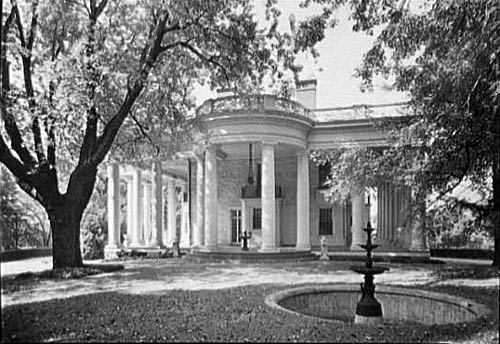
"Duchess de Talleyrand, Lyndhurst, residence in Irvington, New York. Cottage entrance, view I."
1943 Oct. 9.
Library of Congress, Prints and Photographs Division, Gottscho-Schleisner Collection,
Reproduction Number LC-G612-T-44125 DLC.
(This view shows the east facade of the house.)
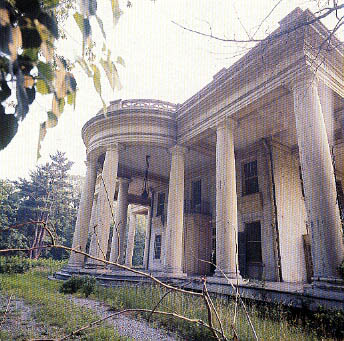
The Colonnades, as it appeared in the 1960s when it was
abandoned.
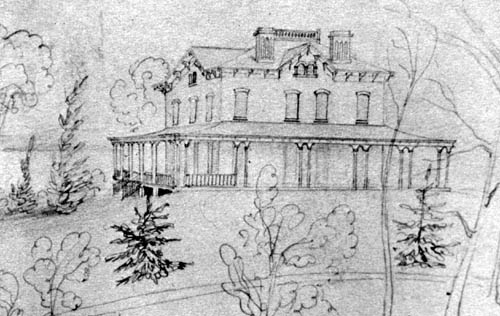
Wolfert's Dell, the Grinnell Mansion (later known as The
Arcades.) Circa 1850-1852.
Sketch by Edwin Whitefield from "The Hudson River and Rail road illustrated."
This illustration depicts the way "The Old House / Colonnades" may originally
have appeared.
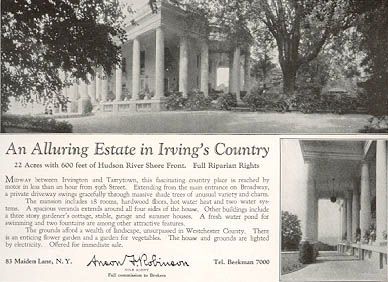
Real estate advertisement, 1927.
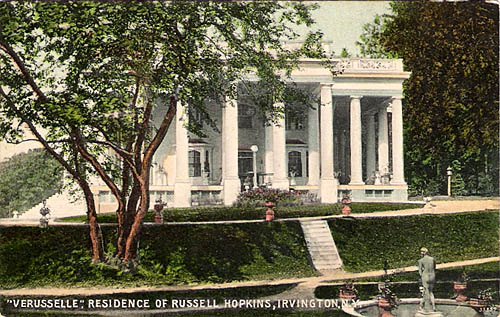
Mansion, south facade and south fountain. Another early 1900s postcard.
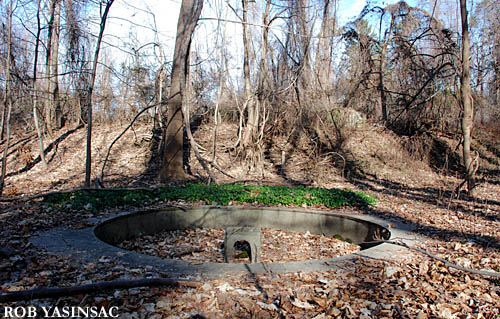
View from similar perspective as above postcard;
photograph taken December 31, 2006.
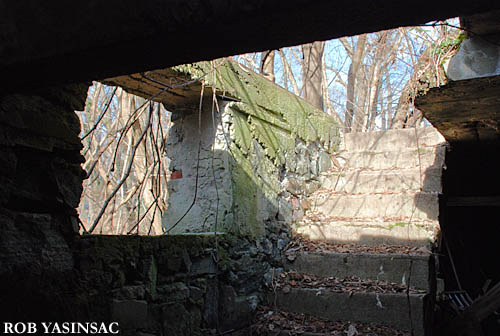
Inside the basement of the garage.

Inscribed in the basement floor of the garage.

Large tree near the Hudson River, possibly over two-hundred years old.
This page copyright ©1997 Robert J. Yasinsac. All rights reserved.